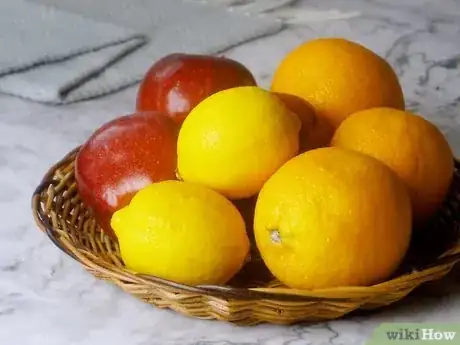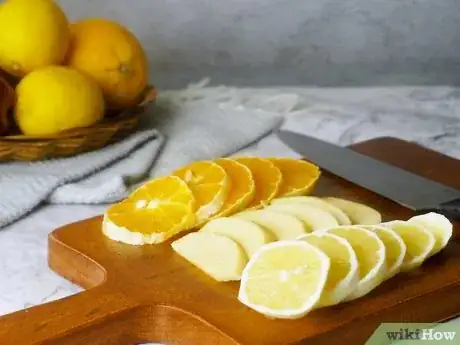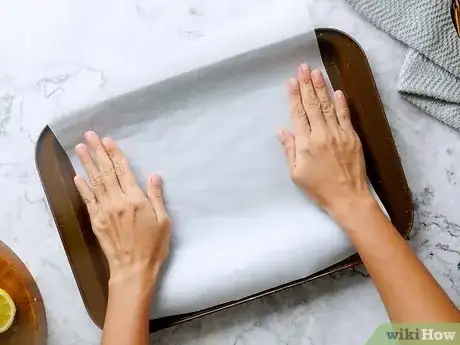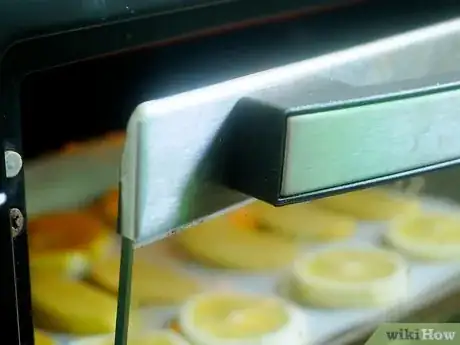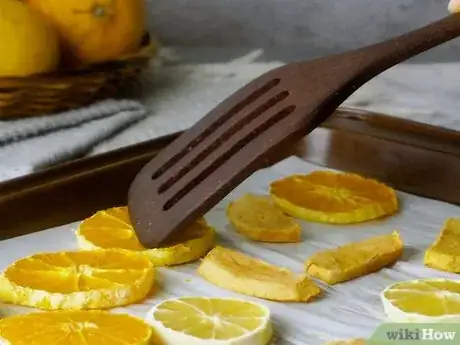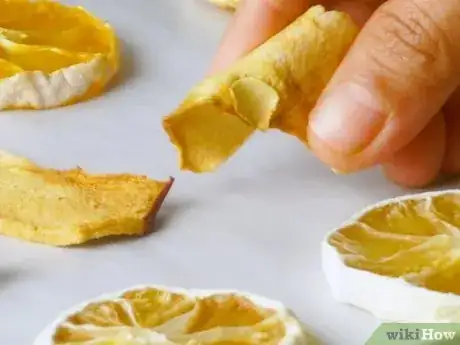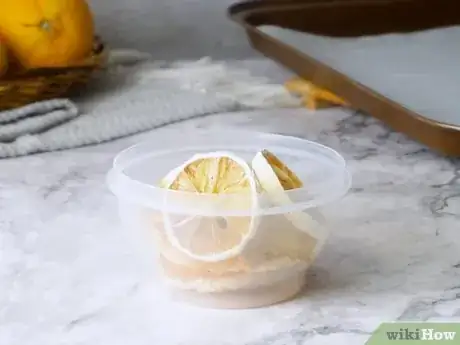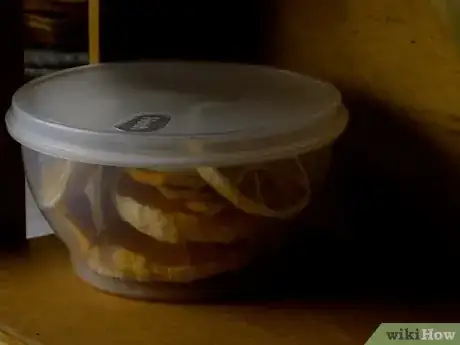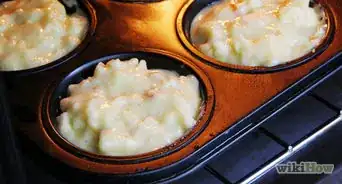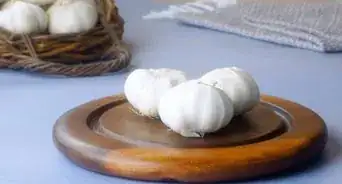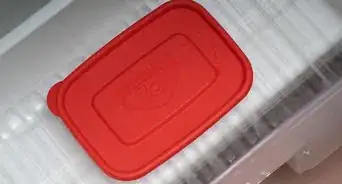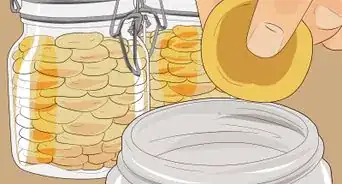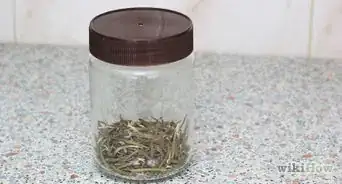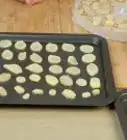This article was co-authored by wikiHow staff writer, Amber Crain. Amber Crain has been a member of wikiHow’s writing staff for the last six years. She graduated from the University of Houston where she majored in Classical Studies and minored in Painting. Before coming to wikiHow, she worked in a variety of industries including marketing, education, and music journalism. She's been a radio DJ for 10+ years and currently DJs a biweekly music program on the award-winning internet radio station DKFM. Her work at wikiHow supports her lifelong passion for learning and her belief that knowledge belongs to anyone who desires to seek it.
The wikiHow Video Team also followed the article's instructions and verified that they work.
This article has been viewed 34,870 times.
Learn more...
Drying fresh fruit yourself is a super easy way to keep plenty of dried fruit on hand without breaking the bank. Prepare the fruits of your choice by rinsing them off and removing any tough skins, rinds, cores, and seeds. Then, cut the fruit into uniform pieces and scatter them in a single layer on a baking sheet. Pop the fruit in the oven and heat it at 140 °F (60 °C) for 4-8 hours. Be sure to let the fruit cool overnight before storing it in air-tight containers!
Steps
Selecting and Cutting Fresh Fruit
-
1Choose fresh fruits that are ripe and bruise-free. A few good options are apples, bananas, pears, peaches, berries, cherries, and apricots.[1] You can also dry sections of citrus fruits like oranges, pineapples, and limes, and experiment with other fruits that you enjoy. Look for ripe fruits with even coloring. Avoid fruit with dark, squishy spots.[2]
- A green stem can indicate unripe fruit. If the fruit feels extremely hard, it's probably not ripe yet.
Tip: Ripe fruit should feel firm to the touch, and if you press down with your finger, it will leave a slight indentation.
-
2Wash, peel, and core the fruit. Always rinse off your fruit thoroughly with cool water before using it. Then, depending on what kind of fruit you're working with, remove the outer skin, stem, seeds, rinds, and cores. You want to work with the fleshy, edible parts of each fruit.[3]
- For example, if you're using peaches, slice them in half so you can remove the pits. Peel off banana skins, remove citrus rinds, core apples, and get rid of any stems.
- It's usually best to remove most tough outer skins. For example, remove the skin from plums, mangoes, and apricots. Leaving the skin on will lengthen the drying time.[4]
Advertisement -
3Cut the fruit into pieces that are uniform in size and thickness. Your fruit slices or chunks can be any size and thickness that you like. The key is to make them as uniform as possible so they'll take about the same amount of time to dry. Keep in mind that the thicker and bigger the fruit pieces, the longer they'll take to dry. The pieces will also shrink down considerably during the drying process.[5]
- For example, cut bananas into round medallions or sticks. Section oranges and other citrus fruits. Cut apples into rings or chunks.
- Small fruit, like blueberries, cherries, and cranberries, can be left whole.
-
4Line a baking sheet with parchment paper. Fruits will release sticky sugars as they dry, so line your baking trays with parchment paper first so the fruits won't cling to the surface. You could also spray your baking sheets with nonstick cooking spray, if you prefer.[6]
- Both techniques work equally well, but parchment paper will make cleanup much easier!
-
5Arrange the fruit in a single layer on the baking sheet. Scatter the fruit pieces on the baking sheet and be sure to leave a little space in between them. The more space you leave, the better the air circulation will be, but as long as the pieces aren't touching each other, you're all set.[7]
Dehydrating the Fruit
-
1Preheat your oven to 140 °F (60 °C) and let it heat up. If your oven doesn't go that low, set it to the lowest temperature you can. Don't exceed 200 °F (93 °C), or you'll end up cooking your fruit instead of drying it. Let the oven heat up completely.
-
2Place the baking sheet in the oven. You can use any rack. If you're making multiple sheets, you can use both racks simultaneously as long as there's at least 2–3 inches (5.1–7.6 cm) of space in between them. Make sure there's at least 1 inch (2.5 cm) of space on all sides of the baking sheet so that the air can circulate properly.[8]
-
3Leave the oven door open about 2 inches (5.1 cm) so air can circulate. Closing your oven door all the way will cut off air circulation, which extends the drying time and may end up cooking your fruits instead of dehydrating them. Leave the oven door propped open a couple of inches to prevent that.[9]
- To be safe, keep children out of the kitchen during this time. You may want to crack a window in the kitchen, since leaving the oven door open will warm up the room.
Tip: You can also set up a fan aimed at the open oven to improve air circulation even more.
-
4Stir the fruit every 30 minutes and let it dry for 4-8 hours total. Use a wooden spoon or a spatula to move the pieces around every half hour so the fruit dries evenly. How long the fruit takes to dry depends on how juicy it is and how big your pieces are, so start checking it around the 3-hour mark to prevent over drying.[10]
-
5Remove the fruit from the oven when it is dry and chewy. If the fruit is squishy, it needs to dry longer. If it's hard, you may have over dried it, which isn't a big deal if you like your dried fruit crispy! The goal is to dry the fruit until the juice is gone, but before it hardens so it retains a chewy quality.[11]
- You can check how dry it is by prodding it with a wooden spoon or scooping up a few pieces on a spatula and testing them out. Be sure to let it cool for a few minutes before you bite into it!
- If you don't have any children or pets, you could turn off the heat and leave the trays in the oven as long as you leave the oven door open all the way.[12]
Cooling and Storing Dried Fruit
-
1Let the dried fruit cool overnight. Leave the fruit pieces on the baking sheet so they can cool and finish the drying process. This usually takes several hours, so leaving it out overnight is the simplest solution. Be sure to place the hot baking sheet on a heat-safe surface in an area where children and pets can't get to it.
- Let the fruit cool in an area away from direct sunlight.
-
2Transfer the dried fruit to air-tight containers. After it cools, you can transfer the fruit straight from the baking sheet into storage containers. Plastic containers and large freezer bags are great options for storage. Vacuum sealing also works well. As long as the containers have air-tight seals, you're good!
- Consider storing the fruit in divided portions. Every time you expose the fruit to air, the shelf life diminishes, so breaking the fruit into portions will keep it fresher for longer.[13]
-
3Store the dried fruit at room temperature for 6-12 months. You can put the storage containers right into your pantry and store dried fruit at room temperature for up to 1 year. If you want to extend the shelf life even more, store the fruit in your fridge or freezer.
- The fruit will last 1-2 years in the fridge and indefinitely in the freezer.[14]
Things You'll Need
- Sharp knife
- Baking sheet
- Parchment paper or nonstick cooking spray
- Spatula or wooden spoon
- Air-tight storage containers
References
- ↑ https://www.tasteofhome.com/article/homemade-dried-fruit/
- ↑ https://spoonuniversity.com/how-to/how-to-tell-when-your-fruit-is-ripe-and-when-to-buy-it
- ↑ https://nchfp.uga.edu/publications/uga/uga_dry_fruit.pdf
- ↑ https://www.myrecipes.com/extracrispy/diy-dried-fruit
- ↑ https://nchfp.uga.edu/publications/uga/uga_dry_fruit.pdf
- ↑ https://nchfp.uga.edu/publications/uga/uga_dry_fruit.pdf
- ↑ https://www.tasteofhome.com/article/homemade-dried-fruit/
- ↑ https://nchfp.uga.edu/publications/uga/uga_dry_fruit.pdf
- ↑ https://nchfp.uga.edu/publications/uga/uga_dry_fruit.pdf
About This Article
To dry fresh fruit in the oven, first wash and peel the fruit, then remove any cores, stems, or inedible seeds. Next, slice the fruit into pieces of uniform size and thickness. Line a baking sheet with parchment paper and spread the fruit out on it in a single layer so that the pieces don’t touch or overlap. If possible, preheat your oven to 140 °F (60 °C). If it doesn’t have a temperature setting that low, set it no higher than 200 °F (93 °C). Put the baking sheet in the oven and leave the oven door open about 2 inches (5.1 cm) to improve air circulation and keep the fruit from overheating. Every 30 minutes, use a spatula to move the pieces of fruit around, since this will help them dry more evenly. It should take about 4-8 hours total to dry the fruit pieces completely, but start checking regularly after about 3 hours to make sure they aren’t cooking or over-drying. Once the fruit is as dry and chewy as you like, take it out of the oven and let it cool overnight on the baking sheet. Store your dried fruit in an airtight container. It should stay good for up to 1 year if you keep it in a dry, dark place, such as a cabinet or pantry.
